- You started playing the taiko drums 40 years ago, and next year will be your 30th year as a solo performer.
- It’s hard to explain but I didn’t intend to be a drummer from the beginning. But I have come this far. That is my honest feeling.
- When you were 19 you joined the drum group Ondekoza that had been started to raise money to establish a vocational college on Sado Island.
- The group was formed to raise money and we were determined to use the taiko drums as a form of entertainment that we could take around the world. The members of the group all lived together at a complex on Sado Island and we trained by running and playing the drums every day in quite a Spartan style that stress stoicism and put on performances that reflected that intensity of spirit. An aim was to show people around the world that Japan had this kind of strong spirit and could produce amazing performances. That was our philosophy for raising money.
Actually, at the time Japanese drumming was a rather rustic and laid back performance medium. The old men we went to study drumming from would drink first and get drunk and then start playing in an adlib style. Today people think the traditional Japanese drumming involves a disciplined group of drummer all playing together in sync, but in fact that form of drumming doesn’t exist traditionally.
In the Sansa festival dances of Iwate prefecture the drummers to play together in time with the dance, but the drumming is accompaniment, it is not the main performance. In the rice-planting ritual called hayashida that has continued since the Heian period (9th to early 12th centuries) they line up drums and play them in unison, but it is something that that should be considered drum dance rather than music centering mainly on drums. Traditional Japanese drumming does not involve groups of drummers playing in unison. There is usually only a single main drummer and he or she plays adlib. At the Bon summer festivals you don’t have groups of drummers playing in unison. They play the drum in time with the song and when the main drummer gets tired he switches with the next drummer. There are no detailed processes or scored phrases that need to be practiced and mastered. That is traditional Japanese folk drumming. In traditional Noh and Kabuki you have what is called the shibyoshi (four part rhythm ensemble) consisting of flute, kotsuzumi (small hand-held drum), Otsuzumi (large hand-held drum) and the taiko (large drum) that play together in a unique rhythm. But, here again, the taiko drum is not the main instrument. It is closer to say that the taiko drum is just one part of the ensemble that accompanies the recited narrative vocals and the shamisen (three stringed Japanese banjo).
At the time, we didn’t intend to recreate folk drumming as it had long existed. We wanted to create a new form of music centered around drums that would have a big impact on people. - Many people think that group drumming is a traditional Japanese art form, but according to what you say, that is a misunderstanding?
- Playing drums together as a group is a form that was created after World War II, called kumitaiko (group drumming). What we were aiming for was a new form that was also different from that. What people call wadaiko today is actually a mix of kumitaiko and the type of taiko I have been doing. By calling it wadaiko (Japanese drumming) it sounds like an old traditional. It has been 40 years since I started doing it, so it does have some history as a genre, but it is definitely not an old tradition.
- Why do you think people see it as an old tradition?
- I think it is because in the early years, when I was drumming with the [Ondekoza] group, we really tried to train our bodies to become folk artists of the land while living on the remote island of Sado. My intention was to create a new form of stage art. That was something that nobody was thinking of doing on that remote island, and no one had been able to do before. I think it was eventually possible because we were not working in a professional context. And, conversely, that is probably why the new music we created looked like a return to traditional roots.
- Was your decision to leave the group and start work as a soloist the result of a desire to pursue drumming as a stage art.
- I didn’t have a clear image of what I wanted to do. It wasn’t as if I was the son of a family in the traditional arts with a heritage to carry on, and I never had the experience of learning the traditional drum (taiko) music of the region where I was born. Actually, I wanted to be a graphic designer originally, but it happened that my encounter was with drumming and I was thinking what I could do with it as a soloist. I didn’t want to copy something that someone else had already done, so the only thing for me to do was to use the taiko drums as a tool to express the things that poured out of me naturally. I had worked with the [Ondekoza] group for 11 years and performed all over the world. The audiences overseas loved our performances and I had the feeling that we had achieved a rather high level of acclaim. The percussionists from the orchestras we performed with would come back stage later and ask me with great interest how we composed our music and how we practiced. From those experiences I had confidence that Japanese taiko drumming was a form of percussion music, and performance, that had not existed anywhere else in the world and that it could be successful.
Personally, however, I felt that I had already done enough in the area of group performance in those 11 years [with the Ondekoza group] and at that point I had to begin solo work. This may sound a bit exaggerated but, at the time such figures as the adventurer Naomi Uemura (known for solo mountain climbing and first solo trek to the North Pole) and the first winner [Class Two] of the “Around Alone” solo yacht circumnavigation of the globe, Yukoh Tada, were famous and I wanted to begin a solo career, too. - After becoming a soloist, there must have been a lot of trial and error in order to find a sound and performance style that was necessarily different from what you did with the group. Did you have any specific image of the style or form you wanted to achieve?
- None at all. I didn’t have any idea of what I wanted to do. It was something no one had done before, so there was precedent to learn from. I just had the idea that I had to do it myself. Since it was a job that required a taiko drum as its principle instrument, it was difficult financially as well. A large taiko drum made from hollowing out a large tree trunk costs several tens of millions of yen (several hundred-thousand dollars). It is a price that could buy a house or an expensive foreign luxury car at the time. Since I didn’t have that kind of money to buy a large taiko at first, I made my own by stretching skin over a cylinder I made of curved veneer plywood about 90 centimeters in diameter. Since it was made of plywood sheets, I only make a straight cylinder without the usual bulge in the center, so the sound wasn’t very good. But, it also had the convenient advantages of being light and easy to transport.
Back when I performed with the [Sado Ondekoza] group we lived communally like monks in a place where we had no newspapers or television, so it was very difficult for me at first when I began living alone in Tokyo with flood of urban stimuli and distractions. For me, everyone I met became a source of learning. So I was determined to never turn down a job and accept any work that came my way. I played back accompaniment for singers, performed at the opening ceremonies for commercial buildings and at parties. I worked hard, believing that I couldn’t be called a pro unless I could give the presenters what they wanted, even it was in a somewhat decadent atmosphere. When I was performing with the group, it was not decadence but a rather intimidating style of performance that we brought to the audience, and that imposing style had been an unexpected success. But now, as a newly independent soloist, I had to provide entertainment. Given my nature, however, I was only able to perform in a serious way. So, when I performed at parties it often didn’t excite the audience (laughs).
From around that time, one of my focuses was performing in front of the drum with my back to the audience. That was the result of a request by the fashion designer Kansai Yamamoto. He was doing a large fashion shows at the time and I got an invitation to perform in it on the taiko for one of the scenes. Playing the large taiko (o-daiko) requires a rhythm accompaniment, and at the time I had been employing another drummer for the rhythm drum accompaniment. But, Kansai-san said he wanted me to perform alone, without the other drummer. Playing the o-daiko alone is like a singer performing completely a cappella. It is very difficult. Kansai-san was able to make such an unprecedented request because he had no experience with drum performance. - That was your performance in July of 1983, the year after you went solo, and it was at the “Yamamoto Kansi Paris Collection” show held in the Niigata town of Gosen. The performance style of facing the drum with your back to the audience was one that you used in your Ondekoza period, I believe, but did you need to make any adjustments when doing it as a soloist?
- The “seitai-gamae” style (facing the drum with your back to the audience) was one that I initiated when I was with the [Ondekoza] group. Since there is no traditional method for maintaining rhythm while playing the large taiko drum, I had to think for myself and improvise a method of my own through practice. But that method became what you could call a shared asset of the group and it was then passed on to groups like Kodo that were formed later, so I had not intended to use it after becoming a soloist. Also, the style of performing in the Japanese fundoshi (loincloth) with a hachimaki (headband) tied around the forehead was too strongly associated with the group style, and it didn’t fit solo performance either. Performing in the loincloth style is a matter of exposing your body in front of people, and in that sense it is embarrassing. Although people complimented it sincerely by saying that the exposed musculature of the back and buttocks was beautiful and I knew that it had a dramatic effect in the performance, I personally didn’t want to expose my body, and I had no intention of doing it from the time I went solo at the age of 30. However, since the seitai-gamae style (facing the drum with your back to the audience) was one that I had invented, I also had the feeling that I wanted to develop and perfect it more. Even when I am performing with my back to the audience, I can still feel the attention of the audience becoming more focused and intense as the performance proceeds. I also developed a solo style that involved playing “drum sets” consisting of Shime-daiko (tighten-type drums) and okedo-taiko (barrel-bodied drums) and practiced to perfect it but, still, nothing compares to the audience response to the sight and the reverberations of the solo drummer beating one large o-daiko. They say it is “awesome!” But it was very difficult training myself to reach that level of performance.
I have to keep my arms raised high above my head and maintain a low lower-body stance with one knee bent and continue to keep the rhythm going without a single moment’s lapse and without breaking that posture. I practice playing that way for 30 minutes or up to an hour. It may sound like boasting for me to say it myself, but I don’t think there is any other example in the world of that kind of long performance on a large drum measuring 130 centimeters in diameter. - It is even difficult to just hold both arms above your head for that long, let alone in that posture and beating the drum the entire time. What’s more, in order to create a performance on a single drum must require careful composition of the sound and everything, and you have to do all this by yourself, don’t you?
- That’s right. In order to make it viable as a solo performance, I have always struggled with the questions of how to compose my pieces. This has been much more difficult than the physical practice. There are no traditional texts to serve as guides for me when considering what direction a piece should take. As I struggled with this question, one idea that came to me was to use traditional Japanese sumi ink paintings as an image. Just as we sense color and space and distance within the gradations of monochromatic grays and black of the sumi ink painting, I thought that perhaps a similar image could be used for the supposed monotone of drum music. I tried a number of things like modifications in the drumsticks (bachi) and changing the surface areas I hit on the drum skin. After a performance I did with the Malaysia Philharmonic, the British conductor said to me, “It’s amazing. I can’t believe you get such finely nuanced sound with such thick drumsticks.” Being originally a percussionist himself, I think the conductor understood the effects of my efforts to create variance in the sound. Classical musicians I have performed with often tell me that my sound is quite colorful, and that is exactly what I have aimed to achieve.
- From around what time did you begin to feel that the “wadaiko” music you were creating began to receive recognition?
- During the 1980s Japan’s hyper economy was headed toward its “bubble” [that eventually burst around 1991], so there were a lot of progressive projects and events going on, and among them there were quite a number of artsy events. I was lucky to have begun my solo career at a time like that. There were a good number of places that were doing experimental projects, like the “Studio 200” project of the Seibu Department Store in Tokyo’s Ikebukuro district and small theater Jan-Jan in the Shibuya district, and they drew a good-sized audience. Near the Eitai Bridge over Tokyo’s Sumida River there was a huge Mitsubishi warehouse with a modern art gallery with bare concrete walls where I did solo performances that lasted for an hour and a half. I also did performances at the Sapporo Ebisu warehouse and at department store product storerooms. It would probably be more accurate to say that my taiko music and performance style developed more from the experiences of performing in these kinds of rather unusual spaces rather than from theater performances. Playing the taiko in places like that produces interesting effects. And, inherently, there is the catabolic effect of having a taiko drum appear in a place you wouldn’t normally expect it. I also performed at temple and shrine grounds, and even in front of the Great Buddha in Kamakura. By doing serious performances in these places that have interesting acoustics and also create good visual stages, my performances began to receive recognition.
- The drum is an instrument that is affected by the environment, isn’t it?
- Yes. The sound and reverberation of a drum is affected by the space it is performed in much more than most people would imagine. The volume of the sound also changes. It seems that many people have the image that they would like to hear a taiko drum performance at grand, open place like the sea shore with the sound of waves rolling in, and sometime presenters even go to the trouble of creating such performance venues. Unfortunately, however, the sound of the drum does not carry well at a place like that. The sound of the drum doesn’t carry or reverberate well unless there is good humidity, the drum shin is moist and there is something for the sound to resonate off of.
- To perform as a soloist, I’m sure that you needed new pieces to perform. Each of your concerts seems to involve not just the sound but a different staging and different means you have developed for “showing” the drumming art. When you compose your pieces, your works, do you consider the staging at the same time?
- There are some cases where I compose the piece first and then think about the movement afterwards, but usually I am thinking about the staging and the “choreography” as I am composing. For example, the sound produced by striking the drum from the front with the right drumstick first and then the left drumstick and then bringing both sticks to a stop will be different from the sound produced by striking the same spots of the drum surface with strokes that come down diagonally from upper left to lower right. The impression created by these two different types of strokes will also different. So, creating a drum piece is a comprehensive process that involves choosing the type of drum(s) based on the sound you want and then thinking about the rhythm, the choreography (movement) and the staging. There are times when I write out the composition as a score in the standard 5-line staff notation and other times when I will compose it strictly through practice, without a score. When it is a piece I am creating with a shakuhachi flute or shamisen musician, we write out the music as a score [in staff notation].
- You have created works that take specific artists (painters) as their theme, such as your 2000 work Jakuchu no Tsubasa (Wings of Jakuchu) based on the Edo Period (18th century) painter Ito Jakuchu famous for his detailed depictions of animals and plants, and your 2002 work Mio no Hasu (A Lotus along the Water Channel) based on the artist Takumi Asakawa who continued to promote the glories of Korean art on the Korean peninsula during the era when it was colonized by Japan. How did you get the idea to base compositions on artists in this way?
- The first of these works was one I did was Manrei in 1998, which took the artist/photographer/designer Man Ray as its subject. This work was very well received and it made me realize that using art or artists as subjects for composing would suit me well and make composing easier. That started the series. For the type of taiko drumming I do, there are no traditional texts (scores) like there are in classical music, and when I was thinking about what I could take as guides or sources for composing works, suddenly Man Ray came to mind. In my teens, I was planning to go to art school and become a graphic designer. So, I felt that I had some knowledge in the art field. When considering motifs for composing, there is a lot to be learned from the traditional [performing] arts field, and although I do like Noh, Bunraku and Kabuki theater, I couldn’t presume to do drum pieces on the great playwrights Zeami and Chikamatsu who gave birth to these theater forms centuries ago. It is a traditional arts world that cannot be broken down in such a way. The idea of doing a work on Man Ray came as a coincidence, but it was also a revelation that opened up new possibilities for me to work freely. It gave me a way to work creatively with what I had inside me.
- The free jazz pianist Yosuke Yamashita and the contemporary music composer Maki Ishii and others have composed music for you. How do you go about staging those works?
- There are now 10 orchestral works that have been written for me to perform on the taiko drums. The composers write out all the music on scores and it is my job to think about how to express it in the performance and what movements (choreography) I will use. In the sense of giving physical form to a written (composed) image, this process is similar to that of an actor bringing a script to life on the stage.
During my [Ondekoza] group performance period, Maki Ishii composed the work Monochrome for Japanese Taiko Drums and Chinese Gong for us in 1976. At the beginning of the score for that work there were there were four piano marks and then just a line of thirty-second notes. Playing it just as it was written might be alright in terms of sound, but it wouldn’t have any character as Japanese taiko music. In order to express the work’s qualities of tranquility and solemnity to the fullest, I thought about ways to work in uniquely Japanese postures and movement. The choreography I came up with involved sitting first in a very slow motion, then the two hand holding the drumsticks are brought together once in front of the face with the sticks pointing up, after which they are brought down slowly toward the drum to begin drumming with a soft ka-ta-ka-ta-ka-ta sound. Even if it is contemporary music, it still has to look and sound like Japanese taiko. I believe that even if it is not written in the music score, it is still the natural type of thing to do for one who calls himself a Japanese taiko drummer. - When performing with orchestras do you do the same kind of traditional Japanese taiko performance staging and use the same drumming style?
- There was never a tradition in Japan of drumming in the style or method that I do use. My performances acquired the style I have because I wanted to express Japanese aesthetics and, although it may sound a bit exaggerated to say it, I wanted to express aspects of Japanese spirituality and thought. In those aspects and in the costume as well, I want people to see a certain beauty in the Japanese, and I want them to see a high-minded, noble aspect of the Japanese. At the same time I wanted the performances as works to be progressive and highly contemporary. Although it may be difficult for some people to grasp, I feel that these two qualities are not contradictory. And in my performances with orchestras it succeeds in both aspects. For Europeans it is completely natural for orchestras steeped in the long tradition of classical music to also perform progressive contemporary music at a very high level. In performing with them this fact has been very evident.
Something interesting happened when I participated in a performance of Ravel’s Bolero with the Paris Orchestre de la Garde Républicaine, which is considered perhaps the best wind orchestra in the world. Although the rest of the orchestra was playing the work as Ravel wrote it, I thought it wouldn’t be interesting if I just played the rhythm as it is written in the score. So, during rehearsals I was boldly trying out some different rhythms, but the conductor came over to me and asked me to stop it, because what I was doing wasn’t the Bolero anymore. At first he had shown interest in my being creative, but when it got too far from the original he couldn’t accept it. It is different from playing with the free jazz pianist Yosuke Yamashita. Still I thought it was great that they had the stance and open-mindedness to program a performance of Bolero with Japanese taiko drumming. An orchestra is a band of close to 100 professional musicians, so it is a great joy to perform with them. But it took a good amount of adjustment before I was able to enjoy it.
When I performed in the premiere of Maki Ishii’s Mono-Prism with the Boston Symphony directed by Seiji Ozawa in 1976, many of the orchestra members covering their ears in the rehearsals. And some members of the orchestra told me outright that my drumming was too loud. Nowadays, at the end of rehearsals orchestra members will applaud me and come up to shake hands and tell me how moved they were and ask for me to pose for a picture with them. I have performed the work HI-TEN-YU for Japanese Drum and Octet written for me by Isao Matsushita nearly 100 times with orchestras around the world, and the atmosphere has changed completely in the process. The response from audiences is good, and especially when I perform in Asia, I often hear comments like, “This is the first standing ovation our orchestra has ever received.” - I guess that is the well-deserved result of 30 years of solo activities. Last year you did your first concert at Tokyo’s Suntory Hall in 11 years. The last time, in 1999, you performed the work Gassan (Mt. Gassan) and this time in 2010 you performed Gassan II (Mt. Gassan II). Unfortunately, I wasn’t able to see that performance live but I did watch it later on DVD. At the beginning of the concert, one measured beat after another on the large taiko drum filled the darkened stage with a quiet stillness like in snow falling, and then a row of lanterns giving off warm light were brought to the stage from the right and left wings. Then, a swath of bluish light shines down diagonally on the white, snow-like stage filled with the sound of chanting by Buddhist priests of the Buzan branch of the Shingon sect. There you make your entrance walking in the suriashi style (slowly sliding the feet across the floor like a Noh actor) along a row of uchiwa-daiko (single-surface) drums, beating each drum as you pass. For the audience, I’m sure that the first piece of the concert titled Shichi Bongo (Buddhist text in praise of Mahavairocana) with its tranquil atmosphere gave the audience a feeling of being spiritually cleansed. From the second piece titled Toge (mountain pass), the drumming gradually becomes more dynamic, and before your final solo piece on the large Taiko, the priests chant while performing the ceremonial sange (scattering paper cut in the shape of lotus petals in obeisance to the Buddha). It was truly a magnificent stage.
When we see the name Gassan we Japanese immediately think of Mt. Gassan in Yamagata prefecture, which is traditionally a sacred mountain in Japan and in the folk tradition it is believed to be one where the souls of the dead go. In the commentary that comes with the DVD of this concert it talks about a “Journey of prayer and rebirth.” Is the title Gassan representative of one of your lifelong themes as an artist? - The final [solo] piece for large taiko in Gassan II is titled “Hi no Taiko, Tsuki no Taiko” (Sun Drum, Moon Drum). The way you illuminate the round surface of the large taiko drum can make it look like a moon or a sun, or a symbol of the universe. Mt. Gassan is said to be a mountain where the souls of the dead are reborn into their next existence in the Buddhist cycle of life. The process called metempsychosis or samsara. There are many people that supported me in my career until now, or people who understood my art, that have now passed on to the next world while I remain in this one. I have the image that, when the time comes, I too will join the flow of that great river and return to a place that might be likened to the sea that the river empties into. My intention with Gassan II was to give expression to this vague image I have of the time spent in this stage of the circle of life.
When I am performing, though, there is no way I can keep that kind of image in mind. The performance itself demands all of my attention. My mind is full thinking about whether I am playing as the piece is written in the score, what do I do to recover when I make a mistake, are the new drumsticks I changed to the right ones? It is like trying to stay afloat in a swift current that could swallow you up at any moment. You can’t allow your concentration to falter for even one second. If a soloist gets swept downstream there is no boat out there to rescue you, so you have no choice but to show your floundering self to the audience. I am often asked what I think about when I am playing the drums, but there is no poetic or romantic answer to that question (laughs). I believe all performers must be like that too. - Haven’t you reached the point in your career where you are starting to think about passing your art on to the next generation?
- Since mine is not a traditional art that has been passed down from generation to generation, I don’t think in those terms. For example, do you think Picasso ever thought about training apprentices to be able to paint like him? It would certainly be boring if all painters painted like Picasso, or Van Gogh, wouldn’t it? Of course there are people who come to me and say they want to learn from me. But it is not a matter of becoming the head of a lineage as in the families of traditional arts [like Noh and Kabuki], or creating a new lineage that would constitute an “Eitetsu school” within the art of wadaiko drumming. I don’t have any interest in creating Eitetsu clones.
- But isn’t there a “master and apprentice” relationship between you and the members of your Eitetsu Fu-un no Kai group?
- The members are in a sense apprentices (deshi in Japanese) because they have come to learn, and I am a master (shisho in Japanese) in the sense that I teach them, but this is a group that I formed like a music unit with the aim of having them all become independent artists in their own right. Around 1995, there was a gradually growing number of people who were asking to become my apprentices, so I began accepting them and having them participate in my performances. Although it may be considered favoritism, the members of the group have done quite a bit of both physical and performance training by now that they are truly excellent. I don’t think you could find an ensemble anywhere that performs with such precision, in terms of both the music and the (choreographed) movement. As soloists, their future lies ahead of them.
- Is it a case of teaching them about the Eitetsu philosophy and the basics of practice rather than just teaching the forms they need to perform? You have also been teaching at a few universities, haven’t you?
- I have taught taiko drumming as an elective in the percussion department of Senzoku Gakuen College of Music for five years and I do one special course a year at the National University of the Arts, Tokyo. I also did one intensive course at the Tsukuba University Graduate School in 2009. Though the total teaching time isn’t long yet, I have organized a taiko drum circle, but none of the participants are approaching the level of the Fu-un no Kai members yet. However, the students in the percussion department are taking on the challenge of writing their own drum pieces, so there might eventually be the possibility of new types of performers emerging.
Since most students today only know Western-style music, and young people who have grown up in the urban environment don’t really know what is meant by the folk arts of the non-urban regions of Japan, I make a point of teaching Japanese taiko drumming in as close to its original form as possible. And I also get them to experience contemporary music. At first I teach them the physical basics of drumming method, and for most of them that is too much for them to handle and they begin complaining.
I always have them practice barefoot. Since olden times the Japanese have eaten sitting on the tatami floor, used a squatting type toilet and led daily lives that involved lots of standing up and squatting down motion. So even when you stood novices in front of drum, they naturally took the [semi-squat, bent-knee] stance taiko drumming requires. But today’s table-and-chair lifestyle has taken the squatting motion out of our lives, so I have to begin by teaching the proper stance. Particularly women who are used to wearing shoes with pointed toes and elevated heels have a difficult time taking a strong stance barefoot, because their toes don’t spread to grip the floor. So their stance becomes unstable as they begin to drum. If you can lower their center of gravity and grip the floor with their bare feet, the upper body can then be used with great freedom. It also looks good, and if you learn how to shift your center of gravity properly, you can move from drum to drum without hurting your lower back. Performers who are able to shift between drums quickly while continuing to play will be praised for their physical abilities.
In some cases students of the music college take my course because the school requires those who want to get teaching certificates to acquire some performance proficiency with Japanese instruments. But the teaching method I use in my course is one that gives them basic performance skills that will be useful experience even if they become orchestra members playing some Western instrument. I tell them that if they work hard to learn my use of the body and drumming method it will be a method they can use their entire life without ever hurting their lower back or the rest of their body. - Today there are a growing number of Japanese taiko drum groups overseas that are performing as professionals foreign, and I imagine that your presence has had a big effect on this phenomenon.
- I believe that the spread of the Japanese-born performance art of taiko drumming overseas is the same type of phenomenon as the overseas popularity of anime, karaoke and sushi. These aspects of Japanese culture have been accepted overseas as forms of what you could call subculture. As one of these, Japanese taiko has indeed spread to an amazing degree. In places like Europe, North America and Australia there are numerous groups that have built their own handmade “wadaiko” drums and are now actively performing professionally and teaching.
Another thing that surprises me is the way that street performers or students who were influenced by the overseas performance tours we were doing from the 1970s have gone on to adapt Japanese taiko in brilliant ways to perfect their own unique types of stage performance. For example, there are shows like the Blue Man group, and the Stomp group of street performers that came out of London and use mops and buckets and such to do rhythm performances. I say that these groups have clearly been influenced by Japanese taiko. If they had tried to do Japanese taiko as it is, that would be nothing more than imitation. What I think is great is the way they have adapted parts of it they can use and gone on to develop their own unique type of performance. - They say that being a pioneer is a lonely job, and it appears that ever since you became a soloist, yours has been a one-man journey.
- When I first went solo, I never expected it would continue as a career for this long. Next year I will be 60. I never dreamed that I would still be performing at this age. But, having a skill and things to express is something I am grateful for. There are of course things that you lose with age, but there are also things that you become able to do that you couldn’t do when you were younger. Being a taiko drummer requires physical capacity close to that of an athlete, but taiko is not an area where success is measured in terms of minutes and seconds. Artistic expression is not measured in numbers, such as how many decibels your sound used to be and how many it is now.
Since this is something that I began, there are no predecessors to be compared with as in the traditional arts, and although I have apprentices of sorts, they will decide their own futures and the future of their art. As for myself, I am still at this age trying to do things that no one has done before, using myself as an experiment, so to speak. It has all been a series of experiments with no defined goal at the outset, so it was not easy and I often failed and embarrassed myself. I guess I came this far because it was always interesting for me.
Eitetsu Hayashi
Innovating drum music,
the spirit of Eitetsu Hayashi
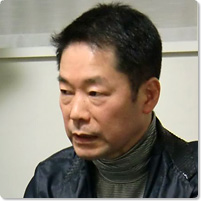
Eitetsu Hayashi
Eitetsu Hayashi, taiko drum artist. Born 1952 in Hiroshima Prefecture. In high school he was inspired by the drumming of the Beatles’ Ringo Star and formed a rock band with friends. After moving to Tokyo in 1971 intent on becoming a graphic designer, Hayashi participated in the founding of the Sado Ondekoza taiko drum group. After participating in the formation of the taiko drum group Kodo, he commenced activities as a solo performer in 1982. Hayashi made his solo debut at Carnegie Hall (New York) in 1984. His career has involved numerous overseas tours and performances with orchestras. Beginning with Manrei (Man Ray) in 1998, Hayashi has composed and staged a series of concerts inspired by artists, also including Ito Jakuchu and Tsuguharu (Leonard) Foujita. In 2010 he staged and performed the concert Gassan II. He teaches as a visiting instructor at Senzoku Gakuen College of Music. Among his writings is the book Ashita no Taiko-uchi e (Toward Tomorrow’s Drumming).
(Interview: Kazumi Narabe, journalist)
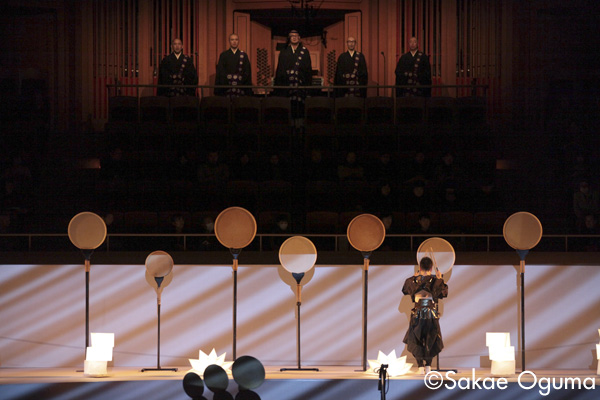
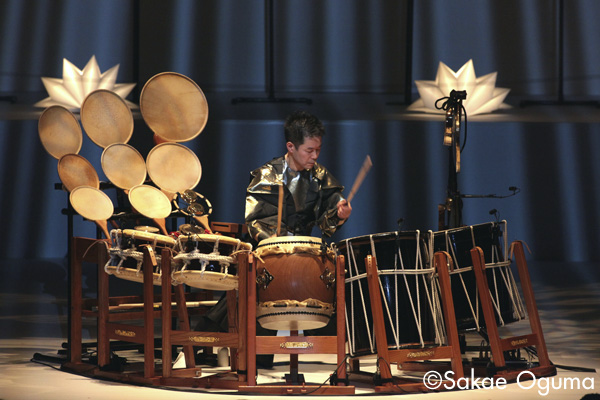
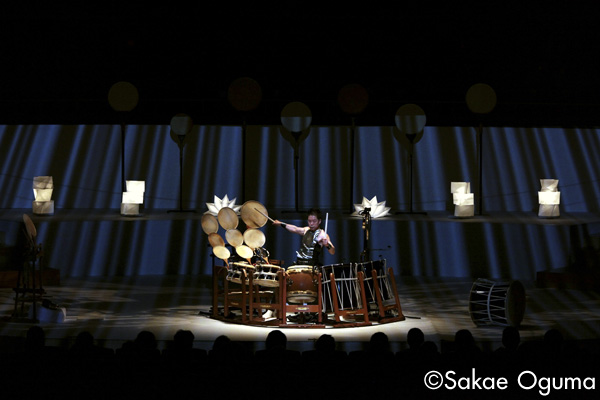
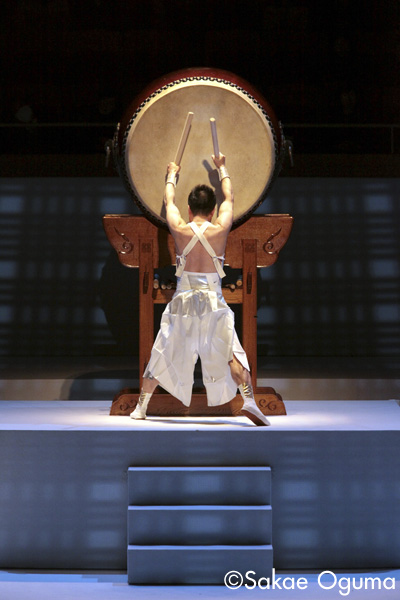
Eitetsu Hayashi Solo concert 2010 Gassan II
(Dec. 2010 at Suntory Hall)
Photo: Sakae Oguma
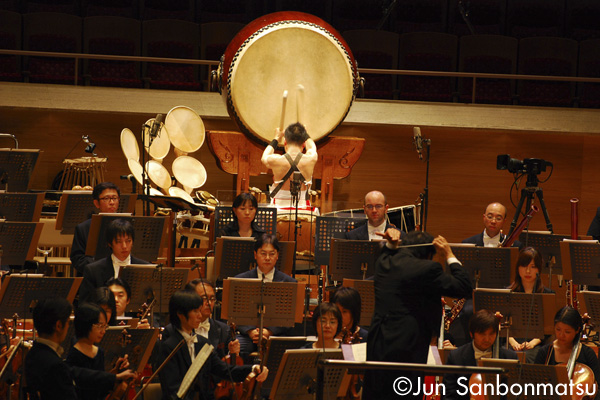
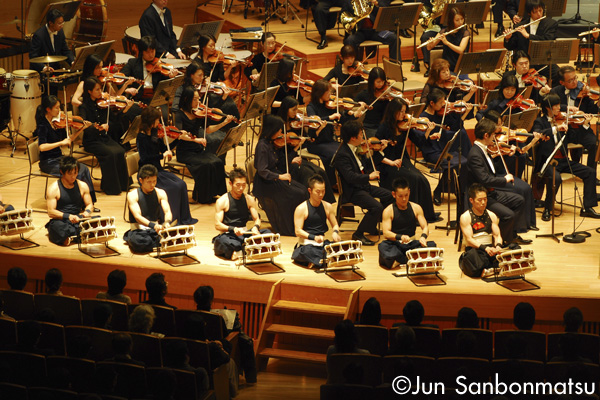
Great Encounter Eitetsu Hayashi with Orchestra
(Dec. 2007 at Suntory Hall)
Photo: Jun Sanbonmatsu
Related Tags

